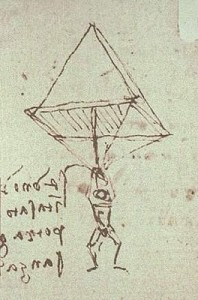|
Da Vinci’s Parachute:
The Dream to Fly (or at least float)
"For once you have tasted flight you will walk the earth with your eyes turned skywards, for there you have been and there you will long to return."
-- Leonardo Da Vinci
Although flight for humans has become second-nature in modern life since the invention of the airplane by the Wright brothers in 1903 and the helicopter by Igor Sikorsky in 1939 , for thousands of years before that, it was just a fantastical dream. However, it was more than a fantasy for Renaissance artist and scholar Leonardo Da Vinci, who actually created a design not only for a rudimentary helicopter but also for a floating device – a parachute . The drawing for Da Vinci’s parachute was found in one of his notebooks dated 1483.
Aspects of the Design
 Da Vinci’s declared: "If a man has a tent made of linen of which the apertures (openings) have all been stopped up, and it be twelve braccia (about 23 feet) across and twelve in depth, he will be able to throw himself down from any great height without suffering any injury."
Da Vinci’s declared: "If a man has a tent made of linen of which the apertures (openings) have all been stopped up, and it be twelve braccia (about 23 feet) across and twelve in depth, he will be able to throw himself down from any great height without suffering any injury."
Da Vinci’s parachute design called for the use of a sealed linen cloth kept open by a series of wooden poles in a pyramid arrangement . The whole contraption was about 23 feet wide and high, not unlike a giant open umbrella, except for its triangular form. Its canopy is one of the most interesting features of Da Vinci’s parachute as it greatly differs from the rounded shapes of modern parachutes. It involved a wooden frame that many assumed would be too heavy for the device to work properly. It also lacked a hole at the top, which scientists deemed necessary in order to keep the whole in balance during a descent from great height.
Surprise, Surprise!
In the year 2000, adventurer Adrian Nichols built a prototype based completely on Da Vinci’s drawings and tested it. He was launched from a hot air balloon in his parachute from a height of 10,000 feet over the wide-open grasslands of Mpumalanga, South Africa. Nichols had created the parachute from the same materials that would have been available to Da Vinci in his time, rather than utilizing modern, light - weight woods and fabrics. The device weighed a very heavy 187 pounds. In order to avoid having the replica crash down on top of him in landing, Nichols cut himself free at the 2,000-foot mark using a contemporary parachute for the rest of the journey. Not only did Da Vinci’s parachute work (in spite of the numerous concerns expressed over the years regarding the design) but Nichols reported that the great man’s device had a smoother ride than the modern parachutes! Just another example of Da Vinci being well ahead of his time.
Earlier Versions
Da Vinci was not the first, however, to imagine the concept of human flight. There are texts from ancient China that describe parachute-like devices, and in the 9th century there is mention of a man using “a huge winglike cloak to break his fall.” An Italian manuscript dated in the 1470s was discovered, showing a drawing of a conical parachute to be used to escape from burning buildings, although there are no actual records documenting its use. In 1595, after Da Vinci, Croatian inventor Faust Vrančić came up with a parachute, which he eventually tested in 1617 by jumping from a tower in Venice.
It was not until 1783 that Louis-Sébastien Lenormand, a French physicist, was credited with creating the first fully functional parachute, although there were counterclaims for invention in 1785 by French aeronaut Jean Pierre Blanchard. In the 1800s, a harness and the idea of packing or folding the parachute into a container was introduced. The modern design combining a harness, foldability and a ripcord was not patented until 1920.
